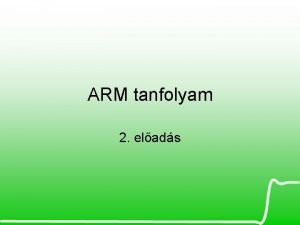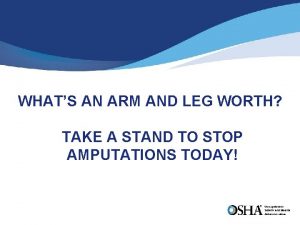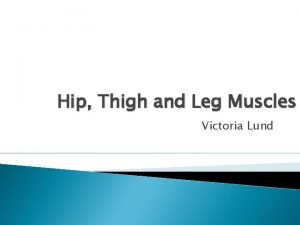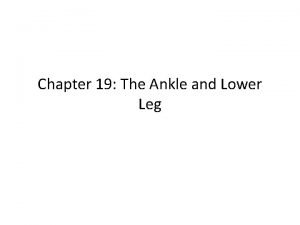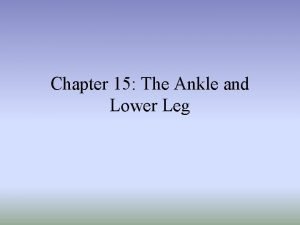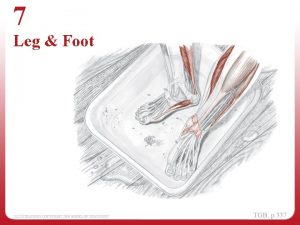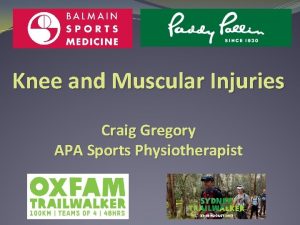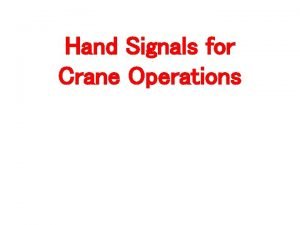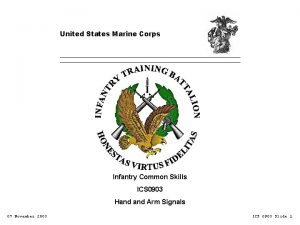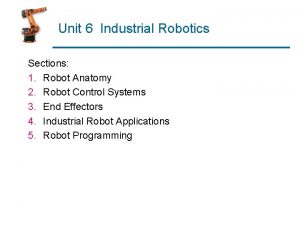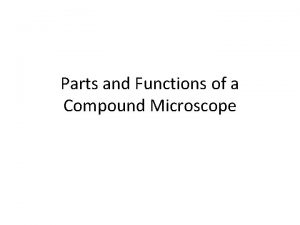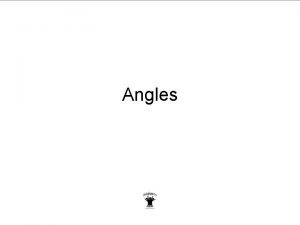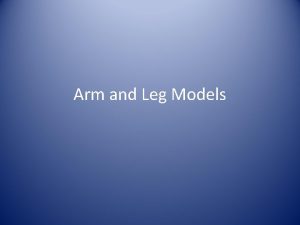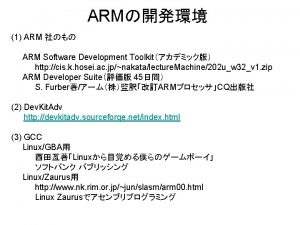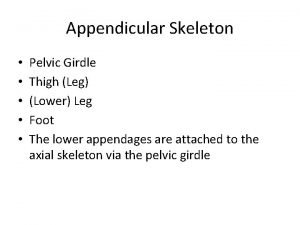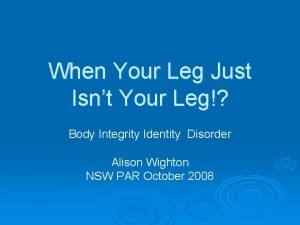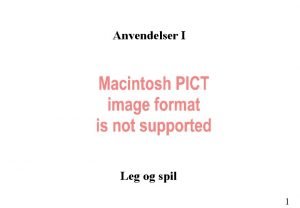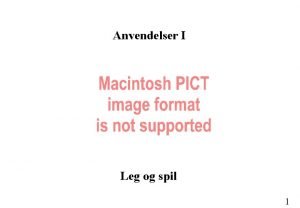WHATS AN ARM AND LEG WORTH TAKE A































- Slides: 31

WHAT’S AN ARM AND LEG WORTH? TAKE A STAND TO STOP AMPUTATIONS TODAY!

Region VI OSHA § Arkansas § Louisiana § Oklahoma § Texas § New Mexico State Plan

Controlling Amputation Hazards Safeguarding is essential for protecting employees from needless and preventable injury. A good rule to remember is: Any machine part, function, or process that may cause injury must be safeguarded.

OSHA Definition: Amputation § An amputation is the traumatic loss of all or part of a limb or other external body part. This would include fingertip amputations with or without bone loss; medical amputation resulting from irreparable damage; and amputations of body parts that have since been reattached.

What is a Loss of an Eye? § Loss of an eye is the physical removal of the eye. This includes enucleation and evisceration. Does loss of an eye include loss of sight? § No. Loss of sight without the physical removal of the eye is not reportable under the requirements of section 1904. 39. However, a case involving loss of sight that results in the in-patient hospitalization of the worker within 24 hours of the work-related incident is reportable.

Region VI -Recordkeeping Reporting Date Hospitalization Loss of Eye Amputation January 1 – December 31, 2015 2, 051 8 612 January 1 – December 31, 2016 2, 021 5 558 January 1 – December 31, 2017 2, 175 2 641 January 1 – December 31, 2018 2, 341 2 692 January 1 – July 26, 2019 1, 310 0 387

FY 15 - Recordkeeping Reporting Area Office Hospitalization Loss of Eye Amputation Austin 132 0 44 Baton Rouge 242 1 51 Corpus Christi 158 0 37 Dallas 235 1 75 El Paso 61 0 6 Fort Worth 245 1 47 Houston North 179 0 59 Houston South 210 0 45 Little Rock 184 2 86 Lubbock 153 2 58 Oklahoma City 157 1 73 San Antonio 95 0 31 2, 051 8 612 Total

FY 16 - Recordkeeping Reporting Area Office Hospitalization Loss of Eye Amputation Austin 131 2 38 Baton Rouge 212 0 61 Corpus Christi 133 0 24 Dallas 237 0 72 El Paso 58 0 10 Fort Worth 248 1 68 Houston North 171 0 48 Houston South 229 2 43 Little Rock 217 0 77 Lubbock 128 0 39 Oklahoma City 153 0 57 San Antonio 104 0 21 2, 021 5 558 Total

FY 17 - Recordkeeping Reporting Area Office Hospitalization Loss of Eye Amputation Austin 151 0 48 Baton Rouge 246 0 53 Corpus Christi 148 0 37 Dallas 260 0 62 El Paso 104 0 20 Fort Worth 252 1 71 Houston North 155 0 70 Houston South 193 0 55 Little Rock 177 1 63 Lubbock 201 0 76 Oklahoma City 181 0 62 San Antonio 107 0 24 2, 175 2 641 Total

FY 18 – Recordkeeping Reporting Area Office Hospitalization Loss of Eye Amputation Austin 152 0 39 Baton Rouge 259 0 69 Corpus Christi 173 1 54 Dallas 265 0 88 El Paso 102 0 20 Fort Worth 239 0 64 Houston North 210 0 60 Houston South 237 0 55 Little Rock 183 0 81 Lubbock 205 1 67 Oklahoma City 204 0 72 San Antonio 112 0 23 2, 341 2 692 Total

FY 19 – Recordkeeping Reporting Area Office Hospitalization Loss of Eye Amputation Austin 95 0 26 Baton Rouge 153 0 44 Corpus Christi 88 0 23 Dallas 173 0 53 El Paso 50 0 9 Fort Worth 148 0 40 Houston North 50 0 28 Houston South 148 0 23 Little Rock 86 0 56 Lubbock 98 0 37 Oklahoma City 91 0 33 San Antonio 72 0 15 1, 310 0 387 Total

CY 2015 – CY 2019 Comparison 2, 341 2, 051 2, 021 2, 175 1, 310 692 612 558 641 387 8 Amputations Hospitalization 5 15 2 Loss of Eye CY 15 CY 16 CY 17 CY 18 CY 19 0

Amputations by NAICS Code Industry Title CY CY CY 15 16 17 18 19 11 Agriculture, Forestry, Fishing and Hunting 12 16 13 21 Mining 63 41 79 90 56 22 Utilities 4 4 7 3 2 23 Construction 81 80 74 84 46 Manufacturing 275 253 288 314 166 Wholesale Trade 36 36 52 32 22 44 -45 Retail Trade 37 28 31 29 30 48 -49 Transportation and Warehousing 23 28 30 39 19 51 Information 2 1 1 3 1 52 Finance and Insurance 4 1 0 0 0 53 Real Estate Rental and Leasing 4 5 7 9 1 54 Professional, Scientific, and Technical Services 8 8 6 6 3 55 Management of Companies and Enterprises 0 0 1 56 Administrative and Support and Waste Management and Remediation Services 35 24 22 32 8 61 Educational Services 0 1 0 2 0 62 Health Care and Social Assistance 4 4 4 7 3 71 Arts, Entertainment, and Recreation 0 4 1 5 0 72 Accommodation and Food Services 8 7 9 5 3 81 Other Services (except Public Administration) 12 11 12 10 11 92 Public Administration 4 6 6 6 2 31 -33 42

Top 3 Industries by NAICS 314 288 275 253 166 63 81 80 79 74 90 84 56 41 CY 15 CY 16 21 - Mining CY 17 23 - Construction FY 18 31 -33 - Manufacturing 46 FY 19

Why an amputation prevention stand-down? 692 Amputations for CY 2018 Top industries § 31 -33 Manufacturing 314 (45%) § 21 Mining 90 (13%) § 23 Construction 84 (12%) Almost exactly the same from FY 2017

Amputations by Area Offices Area Office CY 15 CY 16 CY 17 CY 18 CY 19 Austin 44 38 48 39 26 Baton Rouge 51 61 53 69 44 Corpus Christi 37 24 37 54 23 Dallas 75 72 62 88 53 El Paso 6 10 20 20 9 Fort Worth 47 68 70 64 40 Houston North 59 48 70 60 28 Houston South 45 43 55 55 23 Little Rock 86 77 63 81 56 Lubbock 58 39 76 67 37 Oklahoma City 73 57 63 72 33 San Antonio 31 21 24 23 15 Total 612 558 641 692 387

Machinery Associated with Amputations 1. Mechanical Power Presses 7. Food Slicers 2. Power Press Brakes 8. Meat Grinders 3. Powered and Non. Powered Conveyors 9. Meat-Cutting Band Saws 4. Printing Presses 5. Roll-Forming and Roll. Bending Machines 6. Shearing Machines 10. Drill Presses 11. Milling Machines 12. Grinding Machines 13. Slitters

Common Machinery Hazards Physical Hazards Health Hazards § Fire § Noise § Temperature § Chemicals § Equipment § Dust § Energy § Fumes § Material § Exertion § Machine § Vibration § Falls § Illumination

Hazardous Activities § § § § Machine set-up/threading/preparation, * Machine inspection, * Normal production operations, Clearing jams, * Machine adjustments, * Cleaning of machine, * Lubricating of machine parts, * and Scheduled and unscheduled maintenance. * *These activities are servicing and/or maintenance activities.


What types of machine components are hazardous? § Point of Operation – the area of a machine where it performs work on material § Power-Transmission Apparatuses – flywheels, pulleys, belts, chains, couplings, spindles, cams, and gear in addition to connecting rods and other machine components that transmit energy § Other Moving Parts – machine components that move during machine operation such as reciprocating, rotating, and transverse moving parts as well as auxiliary machine parts

What kinds of mechanical motion are hazardous? § § § § Rotating Reciprocating Transversing Cutting Punching Shearing Bending

Protect Workers from Amputations § Guards provide physical barriers that prevent access to hazardous areas. § Devices help prevent contact with points of operation and may replace or supplement guards.

Criteria for Machine Safeguarding § Prevents worker contact with the hazard area during the operating cycle. § Avoids creating additional hazards. § Is secure, tamper-resistant, and durable. § Avoids interfering with normal operation of the machine. § Allows for safe lubrication and maintenance.

Reporting Fatalities, Hospitalization, etc. § Work-related fatalities must be reported within 8 hours § In-patient hospitalizations must be reported within 24 hours § Amputations must be reported within 24 hours § Loss of an eye must be reported within 24 hours

Report a Fatality or Severe Injury § All employers are required to notify OSHA when an employee is killed on the job or suffers a work-related hospitalization, amputation, or loss of an eye. § A fatality must be reported within 8 hours. § An in-patient hospitalization, amputation, or eye loss must be reported within 24 hours.

OSHA Standards Title 29 of the Code of Federal Regulations (CFR) to protect workers from amputations in the workplace: § 29 CFR Part 1910 Subparts O and P cover machinery and machine guarding § 29 CFR 1926 Subpart I covers hand tools and powered tools § 29 CFR Part 1928 Subpart D covers agricultural equipment § 29 CFR Part 1915 Subparts C, H, and J; § 29 CFR Part 1917 Subparts B, C, and G; § 29 CFR Part 1918 Subparts F, G, and H cover maritime operations

Help is Available § OTI Education Centers, course descriptions, prerequisites and a searchable course schedule that includes training locations and fees can be found at: www. osha. gov/otiec § Resources specifically for small businesses, including information about OSHA’s free On-site Consultation program, can be found at www. osha. gov/smallbusiness § OSHA provides help for employers, including technical assistance about effective safety and health programs, training and education at www. osha. gov/employers

OSHA Training Institute Education Centers Mid-South Alliance Safety Council Oklahoma State University Texas A&M Engineering Extension Service University of Texas Arlington • Email: info@midsouthoti. org • Email: oshaed. okstate. edu • Email: itsi@teex. tamu. edu • Email: web-ded. uta. edu • Phone: 877 -345 -2515 • Phone: 405 -744 -5639 • Phone: 800 -723 -3811 • Phone: 866 -906 -9190 • Website: www. midsouthoti. org • Website: www. oshaed. okstate. edu • Website: www. teex. org • Website: https: //web-ded. uta. edu


www. osha. gov 800 -321 -OSHA (6742)
 Elbow and knee restraints
Elbow and knee restraints Idiomatic paragraph
Idiomatic paragraph Hl congruency
Hl congruency Third class lever sporting examples
Third class lever sporting examples Modified t clasp
Modified t clasp Effort arm and resistance arm
Effort arm and resistance arm Class levers 1 2 3
Class levers 1 2 3 Intracoronal retainer rpd
Intracoronal retainer rpd Annual worth example
Annual worth example Linker arm left arm
Linker arm left arm Anything worth doing is not necessarily worth doing well
Anything worth doing is not necessarily worth doing well Annual worth analysis
Annual worth analysis Whats an arm
Whats an arm Whats it worth
Whats it worth Take a bus or take a train
Take a bus or take a train Whats hot whats not
Whats hot whats not Hamstring insertions and origins
Hamstring insertions and origins Chapter 19 worksheet the ankle and lower leg
Chapter 19 worksheet the ankle and lower leg Chapter 15 worksheet the ankle and lower leg
Chapter 15 worksheet the ankle and lower leg Leg and foot topographical views
Leg and foot topographical views Knee muscle anatomy
Knee muscle anatomy Human arm and whale flipper function
Human arm and whale flipper function Crane operation hand signals
Crane operation hand signals Human arm and whale flipper function
Human arm and whale flipper function Homologous structures and analogous structures
Homologous structures and analogous structures Digital design and computer architecture: arm edition
Digital design and computer architecture: arm edition Leaders join me hand and arm signal
Leaders join me hand and arm signal The curve part of the head containing
The curve part of the head containing Arm in computer organization
Arm in computer organization Joint notation scheme of body-and-arm assembly of scara is
Joint notation scheme of body-and-arm assembly of scara is Compound microscope parts functions
Compound microscope parts functions Kennedy and khrushchev arm wrestling
Kennedy and khrushchev arm wrestling









